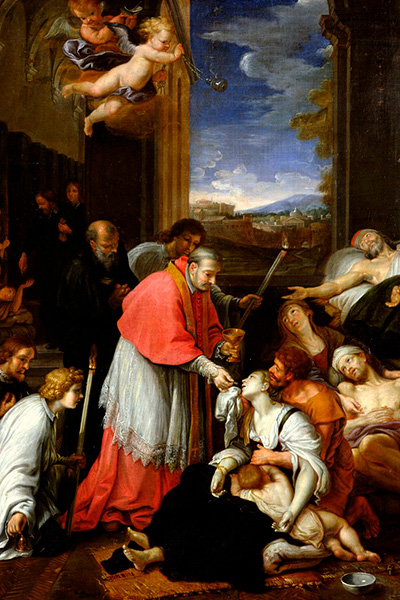Saint Charles Borromeo, born Carlo Borromeo, ranks among the most significant figures of the Counter-Reformation period, not only for his prominence at the Council of Trent but also for the practical implementation of its decisions, particularly within the Archdiocese of Milan. The son of the high Lombard nobility, he was born on 2 October 1538 in Arona, Italy, the son of Gilberto II Borromeo, Count of Arona, and Margherita de’ Medici. He died on 3 November 1584 in Milan and was canonised in 1610 by Pope Paul V, with his liturgical feast day set for 4 November.
Education and Rise in the Clergy
Destined for ecclesiastical life from an early age, Borromeo received the clerical tonsure at the age of twelve. He later graduated as a Doctor of Canon and Civil Law from the University of Padua in 1559. His career in the Church took a decisive leap that same year when his maternal uncle, Giovanni Angelo Medici, was elected Pope Pius IV. Summoned to Rome, Carlo Borromeo, then only 22 years old, was appointed Cardinal Deacon while still a layman, accumulating significant responsibilities, among them that of Secretary of State of the Holy See. He was ordained a priest in 1563 and consecrated bishop shortly afterwards, officially taking charge of the Archdiocese of Milan, where he remained until his death. His highest position within the clergy was that of Cardinal Archbishop of Milan, one of the most strategic and politically complex episcopal sees in Europe.


Participation at the Council of Trent
The role of Charles Borromeo in the Council of Trent was decisive, especially during the final phase of the conciliar sessions (1562-1563). He acted as coordinator of commissions, oversaw the drafting of official documents, and contributed significantly to the writing of the Roman Catechism, prepared to provide a uniform synthesis of Catholic doctrine intended for both clergy and laity. He also defended and articulated liturgical reforms, aiming to standardise rites, ensure unity, and avoid doctrinal ambiguities, factors considered crucial to counter the spread of Protestant doctrines. His vision was profoundly practical: it was not enough merely to formulate conciliar decrees; they needed to be implemented concretely in the dioceses.
Context of the Archdiocese of Milan
Upon assuming the Archdiocese of Milan, Borromeo encountered an ecclesiastical reality marked by disciplinary laxity, scarce catechetical formation, and clergy often absent or involved in worldly matters. Milan, under the rule of the Spanish monarchy, also presented political tensions which complicated episcopal activity. The physical absence of archbishops had persisted for decades, making the presence of firm pastoral leadership urgently necessary.
Reforms Implemented
Borromeo’s reforming activity was directed on multiple fronts. He was among the first to put into practice the Tridentine decree mandating the creation of diocesan seminaries, founding institutions to ensure solid doctrinal, disciplinary, and spiritual formation for the clergy. He conducted intense pastoral visits throughout the diocese, travelling even to the most remote and difficult-to-access regions, with the goal of inspecting, correcting, and guiding parish life.
He established schools of Christian doctrine, encouraged religious confraternities to promote popular catechesis, and issued strict disciplinary norms to regulate ecclesiastical life. On the social front, during the plague of 1576-1578, he organised assistance for the sick, founded temporary hospitals, raised funds, and on several occasions used his personal wealth to aid the population, refusing to abandon the city—an attitude that earned him great prestige among the people.
Architecturally, Borromeo was associated with the reform and construction of various churches, hospitals, and schools in Milan and its surroundings. Although he did not found the Milan Cathedral (Duomo), he promoted important works of completion and maintenance of the cathedral.
Opposition and Attempted Assassination
The reforms led by Borromeo faced significant resistance. Part of the clergy, accustomed to privileges and a comfortable lifestyle, opposed the strict discipline he imposed. Religious orders in a state of decline, such as the Humiliati, became centres of conflict. In 1569, he suffered an assassination attempt within his own chapel, when a member of this order fired at him. The projectile pierced his garments without causing a lethal injury, an episode interpreted by Borromeo as a sign of divine protection.
Beyond the clergy, sectors of the Milanese nobility and Spanish authorities were wary of his influence, both religious and political, which generated constant administrative and diplomatic tensions.
Spirituality and Devotions
In the spiritual dimension, Saint Charles Borromeo was distinguished by an intensely ascetic life. His principal devotion was directed towards Christ Crucified, before whom he spent long periods in prayer, meditation, and penance. He was noted for his zeal for the Eucharist, insisting upon the dignity of the liturgy and the proper celebration of the sacraments, a vision he incorporated both into the liturgical guidelines of the Council of Trent and into pastoral practice in Milan.
Borromeo was deeply devoted to the Virgin Mary, promoting Marian feasts and encouraging confraternities dedicated to the Mother of God. Among the saints, he held particular veneration for Saint Ambrose, patron of Milan, whom he regarded as a model of a zealous bishop and defender of the faith, and for Saint Augustine, whose theological works he frequently read and recommended for the intellectual and spiritual formation of the clergy. His spirituality was characterised by ascetic rigour, including prolonged fasts, vigils, corporal disciplines, and constant practices of mortification, even during periods of intense pastoral activity.
Legacy
Saint Charles Borromeo became firmly established as one of the principal pillars of the practical application of the Tridentine reforms, serving as a model for post-Trent bishops. His actions shaped not only the religious reality of the Archdiocese of Milan but also exerted significant influence over various European dioceses, which began to follow his disciplinary and pastoral guidelines. He is recognised as the patron saint of catechists, seminarians, bishops, and institutions dedicated to religious formation. His name remains associated with the ideal of a zealous bishop—present, disciplinarian, yet also deeply devoted to the spiritual and material well-being of his flock.
Saint Charles Borromeo represents, in the history of the Church, the synthesis between doctrinal firmness and pastoral spirit, serving as a perennial example for the episcopacy and for all those dedicated to the service and reform of ecclesiastical life.
Learn more about the history of the Saints of the Catholic Church
References
BELLONI, Luigi. San Carlo Borromeo. Rome: Edizioni Paoline, 1963.
CHADWICK, Owen. The Early Reformation on the Continent. Oxford: Oxford University Press, 2001.
DEL COLLE, Domenico. San Carlo Borromeo nella Storia della Chiesa. Milan: Ancora Editrice, 1979.
FESSLER, Joseph. Il Concilio di Trento. Rome: Libreria Editrice Vaticana, 1872.
HÜRLIMANN, Martin. Reformation and Counter-Reformation in the Territories of the Old Swiss Confederacy. Basel: Schwabe & Co., 1968.
MARTINDALE, C. C. Saint Charles Borromeo. London: Burns, Oates & Washbourne Ltd, 1939.
MORONI, Gaetano. Dizionario di erudizione storico-ecclesiastica. Venice: Tipografia Emiliana, 1840-1861.
PASTOR, Ludwig von. History of the Popes, from the Close of the Middle Ages. London: Kegan Paul, Trench, Trübner & Co., 1901-1910. Vol. XV-XVI.
PONTIFICAL COMMISSION FOR THE CULTURAL HERITAGE OF THE CHURCH. San Carlo Borromeo, Bishop and Shepherd in the Church of Milan. Milan: Centro Ambrosiano, 1984.
PUJOL, Philippe. Charles Borromée et la Réforme catholique. Paris: Éditions du Cerf, 2007.
TANNER, Norman P. Decrees of the Ecumenical Councils. London: Sheed & Ward; Washington, D.C.: Georgetown University Press, 1990. Vol. 2.
VATICAN. Catechismus Romanus ex decreto Concilii Tridentini. Rome: Typis Polyglottis Vaticanis, 1566.
